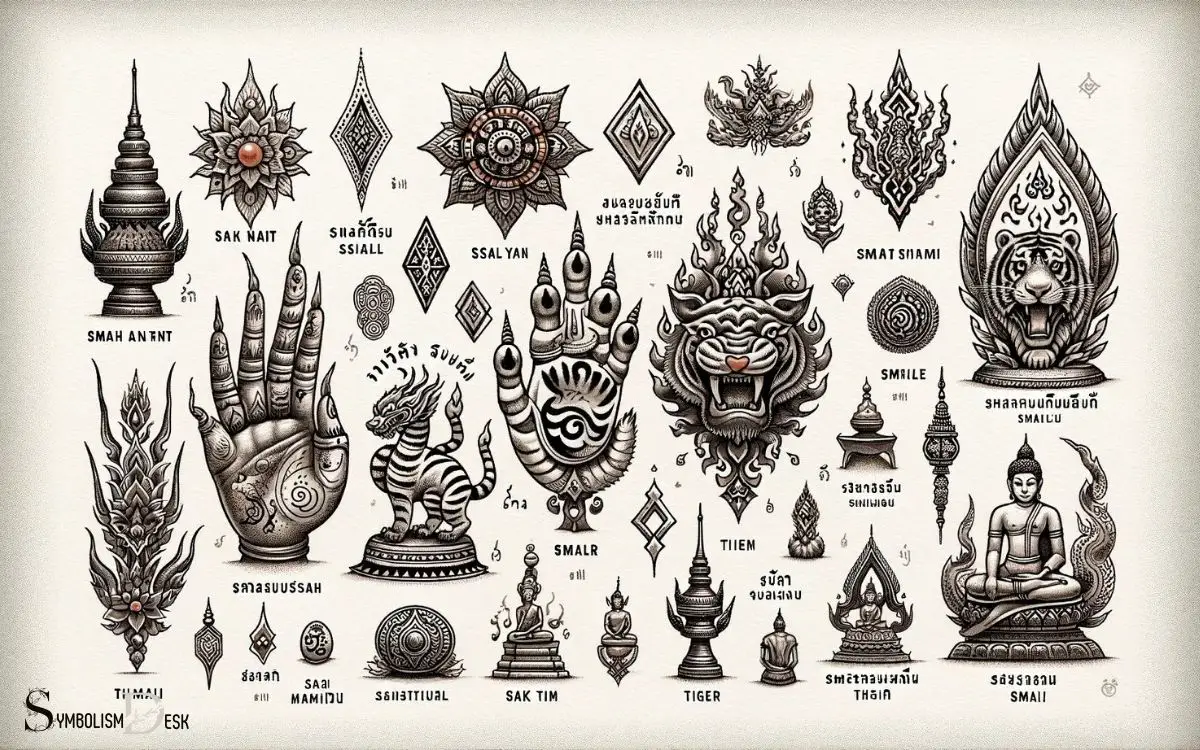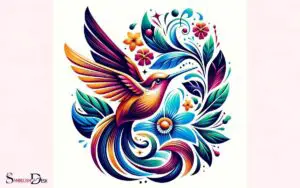Small Thai Tattoo Symbols and Meanings: Luck!
Small Thai tattoo symbols, often linked to the spiritual Sak Yant tradition, carry deep meanings related to protection, luck, and personal growth.
Common designs include the Hah Taew (five sacred lines), Gao Yord (nine spires), and Paed Tidt (eight-directional wheel). Each symbol is believed to confer blessings and specific powers to the wearer.
Thai tattoos, or Sak Yant, are believed to provide various benefits, depending on their intricate designs:
- Hah Taew: Each line represents a specific blessing, such as protection from unwanted spirits and good fortune.
- Gao Yord: Symbolizes the nine peaks of the mythical Mount Meru and is thought to offer powerful protection.
- Paed Tidt: Represents the eight directions of the universe and provides guidance and protection when traveling.
Other symbols include animals like tigers or elephants, representing strength and power or humility and patience, respectively.
Expertly inked Thai tattoos meld spiritual depth with cultural aesthetics, creating meaningful body art that transcends mere decoration.

Key Takeaway
History of Thai Tattooing
The history of Thai tattooing dates back centuries and is steeped in tradition and cultural significance. Thai tattoos, also known as Sak Yant, have been a fundamental part of the country’s culture for generations.
The practice of Thai tattooing is believed to have originated from the ancient Khmer Empire, and it has since been influenced by Buddhism, animism, and traditional Thai beliefs.
These tattoos were initially worn by soldiers for protection and courage in battle, but over time, they became symbols of spirituality, strength, and good fortune.
Each traditional Thai tattoo design holds deep symbolic meanings, often representing elements of nature, mythical creatures, or Buddhist principles.
Understanding the historical and cultural context of Thai tattooing is crucial for appreciating the significance and symbolism behind these ancient and revered designs.
Significance of Small Thai Tattoos
Small Thai tattoos hold significant cultural and spiritual meanings for those who bear them. These symbols often represent an individual’s connection to their heritage, spiritual beliefs, or personal life experiences.
Understanding the significance of these small Thai tattoos provides insight into the rich cultural and symbolic interpretations that are deeply embedded in Thai tattooing traditions.
Cultural Representation in Tattoos
Thai tattoo symbols hold significant cultural representation, reflecting the values and beliefs of the Thai people.
These tattoos often incorporate elements from Buddhism, Hinduism, and traditional Thai folklore, showcasing the spiritual and mythological aspects of the culture.
For instance, Sak Yant tattoos, known for their protective and spiritual significance, are deeply rooted in Thai culture and are believed to provide the wearer with blessings, strength, and protection.
Additionally, symbols like the Thai elephant, the lotus flower, and the yantra designs are commonly used in Thai tattoos, each carrying its own cultural significance.
These tattoos serve as a visual representation of the wearer’s connection to Thai traditions, spirituality, and identity, embodying the rich cultural heritage of Thailand.
This profound cultural representation through tattoos seamlessly intertwines with the spiritual and personal significance of these symbols. This form of artistry often serves as a deeply personal narrative, reflecting an individual’s journey, beliefs, or connections to their heritage. For instance, henna tattoo meanings and symbols frequently carry rich stories of love, prosperity, and protection, making them significant for celebratory occasions like weddings and festivals. Beyond mere aesthetics, these intricate designs act as living canvases of identity and tradition, bridging the ancestral past with modern self-expression.
Spiritual and Personal Significance
Embedded within small Thai tattoo symbols are profound spiritual and personal significances that reflect the wearer’s connection to Thai traditions and their individual beliefs and values.
These symbols often hold deep spiritual meanings, representing concepts such as protection, luck, and guidance.
For example, the Sak Yant tattoos are believed to provide wearers with supernatural powers and protection. Additionally, these tattoos can also hold personal significance, signifying important life events, relationships, or personal mantras.
Each small Thai tattoo holds a unique and deeply personal significance to the wearer, serving as a visual expression of their spiritual and personal journey.
Understanding the meanings behind these symbols provides insight into the rich cultural tapestry of Thai traditions and the individual narratives of those who bear them.
This cultural and personal significance makes small Thai tattoos a meaningful and revered art form.
Moving on to the subsequent section about ‘popular small Thai tattoo symbols’…
Popular Small Thai Tattoo Symbols
Thai tattoos are steeped in cultural significance and carry deep symbolic meanings. Understanding the popular small Thai tattoo symbols involves exploring their historical and cultural context, as well as the interpretations and meanings associated with each design.
Additionally, considerations such as placement and aesthetic aspects also play a significant role in the selection and creation of these small Thai tattoo symbols.
Symbolic Significance of Designs
The small Thai tattoo symbols carry deep symbolic significance, reflecting the rich cultural heritage and spiritual beliefs of the Thai people. These designs often draw from traditional Thai folklore, Buddhism, and nature.
For instance, the lotus flower represents purity and enlightenment in Buddhism, while sak yant designs, such as the Hah Taew, symbolize protection and strength. The use of animals like the elephant embodies qualities such as power, wisdom, and good luck.
Additionally, sacred geometrical patterns like the Yantra convey mystical meanings and are believed to offer spiritual protection.
Each symbol holds a profound cultural and spiritual significance, rooted in Thailand’s history and belief systems, making these tattoos not just aesthetically pleasing but also deeply meaningful.
Understanding the symbolic meanings behind these designs adds layers of appreciation for the art form and the culture it represents.
Cultural Context and Interpretation
Rooted in the cultural and spiritual traditions of Thailand, popular small Thai tattoo symbols hold significant meaning for those who wear them. These symbols are steeped in rich cultural context and carry deep interpretative significance.
- Sak Yant: These traditional Thai tattoos are believed to offer magical powers and protection.
- The Unalome: Represents the path to enlightenment in Buddhism, emphasizing the journey to spiritual growth.
- Hanuman: Depicts the revered monkey god from the Hindu epic Ramayana, symbolizing strength and loyalty.
- Thai Script: Often used to ink powerful mantras or meaningful words, reflecting personal beliefs and values.
- Lotus Flower: Symbolizes purity, enlightenment, and overcoming adversities, drawing from Buddhist teachings.
Understanding the cultural and interpretative aspects of these symbols adds depth to the decision-making process when considering them for a tattoo. This knowledge also aids in appreciating the rich symbolism behind each chosen design.
Moving forward, it’s essential to consider placement and aesthetic considerations.
Placement and Aesthetic Considerations
When considering popular small Thai tattoo symbols, individuals often deliberate on the ideal placement and aesthetic considerations to ensure the desired visual impact and symbolism.
The placement of a Thai tattoo is significant as it can enhance the symbolic meaning and cultural relevance. Traditional Thai tattoos are often placed on specific parts of the body, such as the upper arms, back, or chest.
These placements are chosen to align with the flow of energy, known as ‘Sen,’ within the body and to harmonize with the individual’s spiritual beliefs.
Aesthetic considerations also play a crucial role, with many individuals opting for small Thai tattoo symbols to be intricately designed, incorporating meaningful elements like animals, deities, or sacred geometrical patterns.
The delicate and detailed nature of these symbols allows for versatile placement options, enabling individuals to express their cultural appreciation and personal beliefs through visually striking tattoos.
Traditional Thai Tattoo Techniques
Exploring traditional Thai tattoo techniques involves understanding the intricate process of hand-poking designs with a bamboo rod. This traditional method, known as Sak Yant, holds deep cultural and spiritual significance in Thailand.
The following are key aspects of traditional Thai tattoo techniques:
- Bamboo Rod: The tattoo artist uses a long, sharp bamboo rod to hand-poke the design into the skin.
- Ink Preparation: Traditional ink is made by mixing charcoal and other ingredients, following a specific ritual for consecration.
- Blessing Ceremony: Before receiving a Sak Yant tattoo, individuals often participate in a ritual to seek blessings and protection from the tattoo’s spiritual powers.
- Symbolism: Each traditional Thai tattoo design holds symbolic meanings deeply rooted in Thai culture and spirituality.
- Master-Apprentice Tradition: The art of Sak Yant is traditionally passed down from a master tattooist to their apprentice, maintaining the authenticity and sacredness of the practice.
Cultural Appropriation and Small Thai Tattoos
Small Thai tattoos have become increasingly popular among Westerners, often leading to discussions about cultural appropriation and the significance of these symbols.
Cultural appropriation refers to the adoption of elements from one culture by members of another culture, often without understanding or respecting the original culture’s significance.
When Westerners get small Thai tattoos without fully understanding their cultural and religious meanings, it can be seen as appropriative.
It’s important for those interested in Thai tattoos to educate themselves about the symbols’ cultural significance and to approach them with respect.
Below is a table providing examples of small Thai tattoo symbols and their meanings to help individuals gain a deeper understanding of the cultural significance and symbolism behind these tattoos.
| Thai Tattoo Symbol | Meaning |
|---|---|
| Sak Yant | Protection and luck |
| Gao Yord | Nine peaks representing Buddha’s teachings |
| Hah Taew | Five lines representing five yants for various blessings |
| Tiger | Strength, power, and protection |
| Lotus | Purity, enlightenment, and detachment from materialism |
Choosing the Right Small Thai Tattoo
The importance of understanding the cultural significance of small Thai tattoo symbols and their meanings should guide individuals in choosing the right tattoo for meaningful and respectful representation.
When selecting a small Thai tattoo, one should consider the following:
- Research the specific meaning and cultural context of the chosen symbol.
- Consult with a knowledgeable and respected tattoo artist who understands the cultural significance of Thai symbols.
- Reflect on personal connections or experiences that align with the chosen symbol to ensure authenticity and respect.
- Consider the placement of the tattoo on the body, as certain symbols may have traditional or sacred locations.
- Avoid appropriating symbols that hold deep religious or cultural significance unless one has a genuine and informed connection to them.
Sak Yant Tattoo Symbols and Meanings
Sak Yant is a traditional form of tattooing that originates from Thailand and is deeply rooted in Thai culture and Buddhism. These tattoos are often applied by Buddhist monks or traditional tattoo masters, known as “Arjans,” using a bamboo needle or a metal rod.
Each Sak Yant tattoo design carries its own unique meaning and is believed to offer various forms of protection, blessings, or empowerment to the wearer.
Here are some common Sak Yant tattoo symbols and their meanings:
- Hah Taew (Five Lines): This is one of the most well-known Sak Yant designs, consisting of five lines of script or symbols. Each line represents different blessings and attributes, such as protection from harm, good luck, charisma, and more.
- Gao Yord (Nine Peaks): This tattoo consists of nine points arranged in a grid-like pattern. It is believed to provide protection, spiritual guidance, and the ability to overcome obstacles.
- Paed Tidt (Eight Directions): This design features eight straight lines that radiate from a central point, resembling an eight-pointed star. It is associated with guidance and protection in all directions.
- Tiger (Seua): The tiger is a symbol of strength, courage, and protection. A Sak Yant tiger tattoo is believed to bestow these qualities upon the wearer.
- Hanuman: Hanuman is a Hindu deity who is revered for his strength, devotion, and loyalty. A Hanuman Sak Yant tattoo can provide protection and enhance one’s physical and mental abilities.
- Garuda: Garuda is a mythical bird-like creature in Hindu and Buddhist mythology, known for its power and ability to defeat evil. A Garuda tattoo symbolizes protection and the triumph of good over evil.
- Naga: The Naga is a serpent-like creature associated with water and protection. A Naga tattoo is believed to provide protection from dangers, especially related to water.
- Phra Rahu: Phra Rahu is a deity in Thai mythology associated with eclipses and the swallowing of the sun and moon. A Phra Rahu tattoo is believed to protect against malevolent forces and dark influences.
- Yantra: Yantra tattoos are intricate geometric designs that incorporate various symbols and sacred geometry. They are believed to offer a wide range of spiritual benefits, such as protection, luck, and success.
- Baramee (Virtue): This tattoo represents virtue and moral conduct. It is often chosen by individuals seeking to improve their character and lead a more righteous life.
- Metta (Loving-kindness): The Metta Sak Yant symbol represents loving-kindness and compassion. It is chosen by those who wish to cultivate and spread love and goodwill.
- Sakyant Wheel: This design resembles a wheel with spokes and is associated with spiritual development, inner strength, and the pursuit of enlightenment.
It’s important to note that receiving a Sak Yant tattoo should be done with respect for the tradition and its cultural significance.
Conclusion
As one delves into the world of small Thai tattoo symbols and their meanings, it becomes clear that these intricate designs hold deep cultural significance and historical roots.
From ancient traditions to modern interpretations, the art of Thai tattooing continues to captivate and inspire.
Those seeking to adorn themselves with these powerful symbols must carefully consider the cultural context and symbolism behind each design, ensuring a meaningful and respectful choice.






